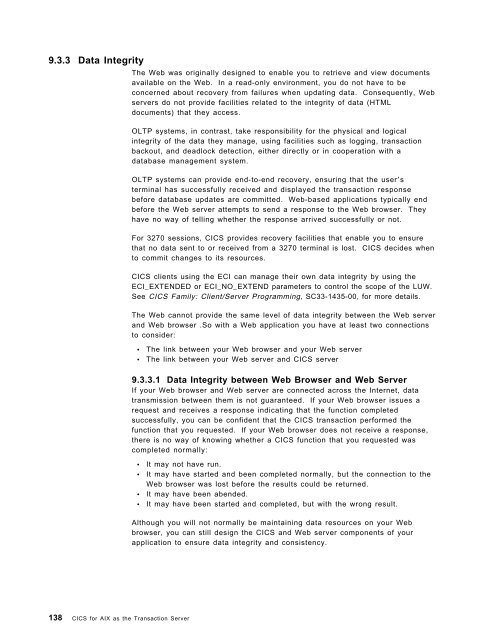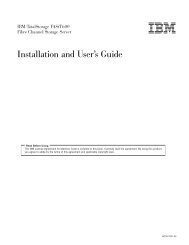Addressing OLTP Solutions with CICS: The Transaction Server ... - Ibm
Addressing OLTP Solutions with CICS: The Transaction Server ... - Ibm
Addressing OLTP Solutions with CICS: The Transaction Server ... - Ibm
Create successful ePaper yourself
Turn your PDF publications into a flip-book with our unique Google optimized e-Paper software.
9.3.3 Data Integrity<br />
<strong>The</strong> Web was originally designed to enable you to retrieve and view documents<br />
available on the Web. In a read-only environment, you do not have to be<br />
concerned about recovery from failures when updating data. Consequently, Web<br />
servers do not provide facilities related to the integrity of data (HTML<br />
documents) that they access.<br />
<strong>OLTP</strong> systems, in contrast, take responsibility for the physical and logical<br />
integrity of the data they manage, using facilities such as logging, transaction<br />
backout, and deadlock detection, either directly or in cooperation <strong>with</strong> a<br />
database management system.<br />
<strong>OLTP</strong> systems can provide end-to-end recovery, ensuring that the user′s<br />
terminal has successfully received and displayed the transaction response<br />
before database updates are committed. Web-based applications typically end<br />
before the Web server attempts to send a response to the Web browser. <strong>The</strong>y<br />
have no way of telling whether the response arrived successfully or not.<br />
For 3270 sessions, <strong>CICS</strong> provides recovery facilities that enable you to ensure<br />
that no data sent to or received from a 3270 terminal is lost. <strong>CICS</strong> decides when<br />
to commit changes to its resources.<br />
<strong>CICS</strong> clients using the ECI can manage their own data integrity by using the<br />
ECI_EXTENDED or ECI_NO_EXTEND parameters to control the scope of the LUW.<br />
See <strong>CICS</strong> Family: Client/<strong>Server</strong> Programming, SC33-1435-00, for more details.<br />
<strong>The</strong> Web cannot provide the same level of data integrity between the Web server<br />
and Web browser .So <strong>with</strong> a Web application you have at least two connections<br />
to consider:<br />
• <strong>The</strong> link between your Web browser and your Web server<br />
• <strong>The</strong> link between your Web server and <strong>CICS</strong> server<br />
9.3.3.1 Data Integrity between Web Browser and Web <strong>Server</strong><br />
If your Web browser and Web server are connected across the Internet, data<br />
transmission between them is not guaranteed. If your Web browser issues a<br />
request and receives a response indicating that the function completed<br />
successfully, you can be confident that the <strong>CICS</strong> transaction performed the<br />
function that you requested. If your Web browser does not receive a response,<br />
there is no way of knowing whether a <strong>CICS</strong> function that you requested was<br />
completed normally:<br />
• It may not have run.<br />
138 <strong>CICS</strong> for AIX as the <strong>Transaction</strong> <strong>Server</strong><br />
• It may have started and been completed normally, but the connection to the<br />
Web browser was lost before the results could be returned.<br />
• It may have been abended.<br />
• It may have been started and completed, but <strong>with</strong> the wrong result.<br />
Although you will not normally be maintaining data resources on your Web<br />
browser, you can still design the <strong>CICS</strong> and Web server components of your<br />
application to ensure data integrity and consistency.
















